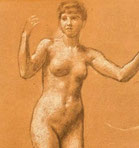Sir Edward John Poynter

Sir Edward John Poynter (1836-1919) was son of painter and architect Ambrose Poynter (1796-1886) and a great-grandson of sculptor Thomas Banks (1735-1805).
Although Edward didn't become an architect or sculptor, both arts marked his early interests and helped to pave his own way into arts. Beside being a painter and illustrator, he also designed medals, coins, wall papers and tiles.
He had impressive academic career, with achieving a position of Associated Member of Royal Academy in 1869, Slade Professor at University College London in 1871, Royal Academician in 1876 and President of Royal Academy in 1896 where he kept the position until 1918.
He also occupied position of the Director of National Gallery between 1894 and 1906 as the last practicing artist in this function.
Edward Poynter was born in 1836 in Paris but lived most of his childhood in Britain, attending Brighton College and Ipswich School. His ill health forced him to leave school, yet gave him opportunity to meet Frederic Leighton in Rome, one of the places where young Edward spent winters. Leighton was definitely greatest artistic influence on Poynter. He spent few years studying in Rome, Paris and London, where he produced his first illustrations.

Edward John Poynter married Agnes MacDonald in 1866. They had three children. Some trivia about her three sisters:

- Alice was the mother of famous writer Rudyard Kipling (1865-1936)
- Georgiana was married to famous painter Edward Burne-Jones (1833-1898)
- Louisa was the mother successful politician Stanley Baldwin (1867-1947), who was a Prime Minister of United Kingdom three times in 1920s and 1930s
While dramatic paintings with classical themes from Greek Mythology and Bible made him famous, we decided to present a fine selection of portraits of sirens, water nymphs and related magical creatures.

In 1896 he became a knight, in 1898 got an honorary degree by Cambridge University and was made a baronet in 1902. Many historians believe he was a Freemason. He died in London.
 Fairy Land
The World of
Magical Creatures
Fairy Land
The World of
Magical Creatures


